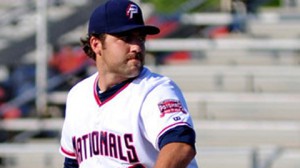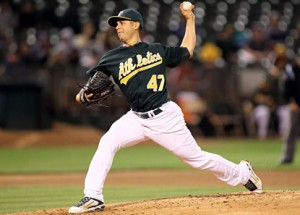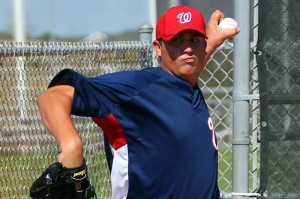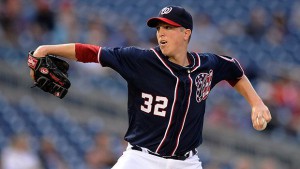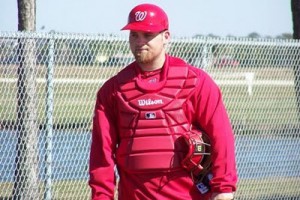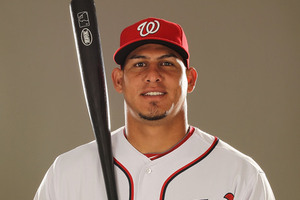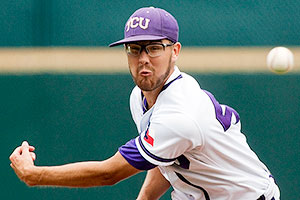- Click here for the 2011 version of this post, for a look at how things were last year.
Here’s the High-A version of the 2012 season pitching staff review. I’m going down the line from top to bottom; AAA is here, AA is here. As with the other reviews, we’ll look at the main rotation, the substitute and spot starters, then focus on key relievers. Rehab appearances are generally not mentioned.
Potomac starters. The rotation started the season with Winters, Hansen, Olbrychowski, Grace and Swynenberg. Lets see how the original rotation and other primary starters fared.
- Kyle Winters, an off season minor league free agent pickup, was Potomac’s opening day starter. But he wasn’t long for the rotation; he got shelled en-route to posting a 7.02 era in 8 starts before getting released. It does not seem like anyone else picked him up (except perhaps in Indy ball). Lets be honest; it is never a good sign to have minor league free agents playing significant roles on high-A ball clubs. Outlook for next season: in another organization or out of baseball.
- High-A proved to be too much for Bobby Hansen, who put up a 5.85 ERA in 6 starts (9 total appearances) before being moved back to Low-A, where he spent 2011. He’s young; he has yet to turn 23, so even low-A isn’t the worst place for him. But he’ll be entering his 6th pro season in 2013 and you’d like to see him throw more than 50 innings in a season. Outlook for next season: see the Low-A post.
- Adam Olbrychowski wasn’t able to build on his 2011 season in High-A, regressing badly and posting a 6.24 ERA in 26 appearances (16 starts). He lost his rotation spot halfway through the season and didn’t fare well out of the pen. This trade didn’t work out for either team really (the Nats traded Justin Maxwell to the Yankees for Olbrychowski in January 2011 and released him themselves; he now plays for Houston). Outlook for next season: either one last shot in the High-A bullpen or released.
- Matthew Grace put in his third year as a full-time starter with the Organization, and he continues to be hit or miss. On the season he posted a 9-12 record with a 4.84 ERA and 83/48 k/bb ratio in 141 1/3 innings, but you never know what you’re getting with him. His final start of the season featured 8 shutout innings, but his first start in August was a 3-inning 9 hit meltdown. Outlook for next season: the organization stuck with him after a 5.17 ERA in a full season of low-A; no reason to think they won’t continue to stick with him in 2013. AA rotation, perhaps re-peating High-A if the numbers don’t work out.
- Matt Swynenberg was in and out of the rotation, not really excelling as either a starter or a reliever on the year. 7-5, 4.92 ERA on the season. He was a bit unlucky on the season; he had a .343 BABIP and his FIP was a bit lower than his ERA. Outlook for next season: he’s still young (turned 23 in February) and has plenty of time to improve. And, given that he was a 28th round draft pick, anything he contributes is absolute gravy to the organization). Look for him to be leading the High-A rotation in 2013 with an eye for mid-season promotion.
- Robbie Ray was last year’s sensation, an 19-yr old dominating in Low-A. He clearly suffered from a sophomore slump, going 4-12 with a 6.56 ERA in 22 “starts” (I put that in quotes since he had one 5-inning “relief” appearance in June). What happened? His K’s were down, Walks up, HRs up, BABIP unlucky, and his FIP was a full point and a half lower than his ERA. So it wasn’t as bad as it looked. Plus, he’s only 20 in high-A, where a lot of college guys take a year and a half to get to. I’m not worried at all; i’ll bet he’s back to being dominant in 2013 repeating the level. Outlook for next season: back in the High-A rotation.
- Nathan Karns finally got a healthy full season of pitching under his belt after getting paid 3rd round money as a 12th round draft pick in the high-spending 2009 draft, and the organization finally got a look at what Karns can do: A 2.17 ERA in 24 appearances (18 starts) across 116 innings between low- and high-A. This was no fluke either; all his advanced stats support his performance and give reason to believe he’ll continue to develop. He was named the Organization’s Pitcher of the Year for 2012, usually a great indicator of future success for this team. He’s a big guy with a great pitching frame (6’5″, 230lbs) and an even better mustache (see his profile picture at milb.com). I think Karns may be our best or 2nd best starter prospect right now. A ight concern may be his hitting the DL in mid-August after a couple of mediocre outings; I’d guess that he’s reached an innings limit for the season and was shutdown with an unspecified injury. This may also explain why he’s not appearing in the AFL after such a season. Outlook for next season: AA rotation.
- Trevor Holder finally got promoted past high-A after repeating the league for the 4th time in 2012. He got 10 starts in Potomac before being moved up mid-season. He was pretty good in his 9 starts in High-A this year: 3-3 with a 3.72 ERA. Outlook for next season: (from the AA post): AA Rotation.
- Alex Meyer excelled in 7 late-season starts in Potomac after throwing 90 innings in low-A to start the year. Final high-A stats: 3-2 with a 2.31 ERA in 39 innings. His ancillary numbers declined slightly moving from low- to high-A (as one would expect), but his core capabilities seem to be the same. He’s a HUGE guy (6’9″) and the downward plane on his fastball makes it incredibly difficult to hit in the air (only 6 homers allowed in 139IP). A lot of pundits (myself included) were critical of Meyer starting in low-A as such an advanced draft prospect, but his numbers in high-A (a more legitimate evaluation of his skills age- and experience-wise) give great hope. The organization has had him working on mechanics all year, worried that such a big guy was going to struggle to repeat his delivery (as highlighted by this Baseball America article, subscribers only sorry). After being basically a 2-pitch guy in college, Meyer has reportedly added a 2-seam fastball that he throws at the same velocity as his 4-seamer to go with an 87-mph change-up. Suddenly he’s a 4-pitch guy (2 plus-plus, one plus and one fringe) and that gives him a great chance of remaining a starter. A 6’9″ throwing upper 90s has to look like 100+ to a hitter based on his release point, and despite most scouts opinion that he’d make a fantastic shut-down closer with his 2 plus-plus pitches, he has more value to the team as a starter. Outlook for next season: I think he starts in High-A rotation again with an eye towards quick promotion to AA.
- Robert Gilliam underperformed in AA, got demoted to high-A and gave Potomac 7 up-and-down starts down the stretch. Final numbers in Potomac: 1-2, 4.25 ERA in 36ip. Outlook for next season: (cut-n-pasted from AA post): The team likes him as a starter; i’m guessing they give him another whirl in the AA rotation with Meyer sitting in High-A waiting in the wings.
- Taylor Hill got three late-season starts after toiling all year in Hagerstown. Outlook for next season: see Low-A post.
- Other guys who got spot starts here and there (non-rehab):
- Ryan Demmin served as the mop-up/swing man for the team, giving them a K/9 reliever with a 4.57 ERA on the season. He got a couple of spot starts but only went 7 innings between the two. He gives up a lot of hits but doesn’t walk guys. He could continue to be a useful middle reliever. Outlook for next season: Likely the high-A bullpen again, though he could slot up to AA if the numbers don’t work out.
- Paul Applebee, as with Demmin, was used mostly as a long man and got a spot start before going down with injury in June. He wasn’t great when he did pitch (5.00 era in 36ip), but he’s been useful in the organization for a while. Outlook for next season: High-A mop-up guy again, not knowing how severe his arm injury is.
Potomac Relievers: taking a look at the relief corps at the end of the season. They used an awful lot of them.
- Neil Holland continued an excellent string of seasons for this organization since being drafted in 2010. He was close to unhittable in 2012: a 1.64 era in 60 innings and a sub 1.00 whip. That’s fantastic. Outlook for next season: see if he can repeat his performance in AA.
- Rob Wort had, frankly, a pretty amazing season as Potomac’s closer. He had an era of 2.38 over 56 2/3 innings, and had 13 saves. That’s not why he was amazing; He had 95 Ks in those same 56 2/3 innings. That is a 15.09 K/9 rate!! For a 30-th round draft pick (i.e., a guy who was never really expected to make it out of rookie camp), that’s incredible. Outlook for next season: closer in AA.
- Joe Testa couldn’t repeat his excellent 2011 Potomac results, putting up an ugly 5.17 era in 38 IP. The ugly part? A perfect 1-1 ratio of walks to strikeouts on the year (31 walks, 31 Ks). He turning 27 in December and is entering his 6th minor league season; I think its safe to say 2013 is a “show me” year for Testa. Outlook for next season: hard to see him moved up to AA; I see him repeating in the High-A bullpen, perhaps a pure Loogy.
- Cameron Selik looked to have “figured out” the bullpen after being a starter for most of 2011, and had a fantastic 34/3 k/bb ratio in 22 high-A innings. He earned a promotion, but begged out of his AA debut with what probably was a torn Lat. He didn’t pitch again after June 5th. A shame, since it would have been nice to see how he fared upon reaching AA. Outlook for next season: I’d start him in the High-A bullpen again to make sure he’s healthy, then promote him up to AA.
- Aaron Barrett has gone from unknown 9th rounder to organizational top prospect in one season; after tearing through Low-A with 52 Ks in 34 innings, he allowed just 2 runs in 17 high-A innings to close out the year. His performance earned him a trip to the Arizona Fall League along with a number of other high-profile Nats prospects. Outlook for next season: As with Selik, I’d imagine he belongs in the AA bullpen; we’ll see if the numbers work out. If not he starts in Potomac looking for a quick jump.
- Josh Smoker, the Nats poster child for NOT drafting high school arms early, threw a grand total of 9.2 innings between three levels this year. Its hard to believe, but he’ll play his 6th minor league season in our system in 2013 and then he’ll likely move on. Outlook for next season: if healthy, High-A bullpen to try one last time to resurrect his Nats career.
- Other Relievers who appeared in High-A of note (not including Rehabbing MLBers): Outlook for next season for all of these guys seems the same: either continued “org guy” middle reliever or minor league FA in another organization.
- Adam Carr, a 28-yr old in high-A after spending most of 2011 in AAA. Org arm.
- Jimmy Barthmaier looked great in 19 High-A innings; he should since he’s 28 and in his 8th minor league season.
- Shane McCatty struggled through a 6-week mid-season injury and an 8.83 ERA in high-A. Nepotism seems to indicate that he’ll get another shot in 2013, deserved or not.
- Wilson Eusebio was promoted twice, both times inexplicably based on his performance, and ended up getting lit up in Potomac. He may be out of baseball after 2012.
Summary
Summary Potomac’s 5 opening day starters finished the season with these ERAs: 7.02, 5.85, 6.24, 4.84 and 4.92. Thankfully guys like Meyer, Holder and Karns replaced some of these starts with decent ones later on in the season. They got great performances up and down the bullpen though, which helped the team to remain in playoff contention late into the 2nd half (despite their sub .500 record). At least they were dominant at home (21-13 first half, 21-15 second half), giving the Potomac fans a lot to cheer for.
